Home | Front Page | Index | Blog | New | Contact | Site Map
Orange Walk
Lamanai
Belize City
San Ignacio
Cahal Pech
Xunantunich
El Pilar
Placencia
Foto Show

Teotenango
Xochicalco
Monte Alban
Mitla
Palenque
Uxmal
Chichen Itza
Tolum
Tikal
Copan

Route Maps
Guatemala
Honduras
Nicaragua
Costa Rica
Panama
Mexico 2003-04:
2003-04
On our third day in Orange Walk we made our first touristic effort by driving to the Mayan site of Lamanai. The standard way to get there is to take a river launch, sort of an overgrown row boat, powered by an outboard motor. While investigating the ways and means of going to Lamanai Gerry spoke with a man who runs a boat service. The man, now 60, says that years ago his father did the trip by canoe; then the silence was wonderful but it took 12 hours to go there and back. At an intermediate time, about 15-20 years ago he made an old fashioned Mayan canoe from a log and added a long-shafted screw propeller. That reduced the time, but not to the current norm of 1.5 hours.
The largest group of visitors to Lamanai seems to be passengers from cruise ships: they come from New York or Miami, dock for the day off of Belize City, and manage to get their groups there and back before sunset. They drive by bus to the New River, set off on the boat, and then get to spend about three hours, including lunch, at Lamanai.
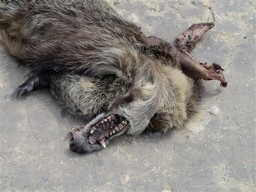
Dead howler monkey with exposed jaw. |
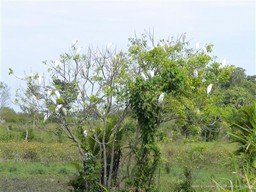
Tree with roosting white egrets |
We elected to drive. That had its pluses and minuses: we got to control our departure time and make whatever stops we wanted to. We missed the river trip, said by guide book and all with whom we talked to be a great trip, with sightings of crocodiles and numerous kinds of birds. In its place we got to take a road that got worse and worse, bouncing the car about. But we did see wild life, including a dead howler monkey lying in the middle of the road and a tree filled with lovely white egrets.
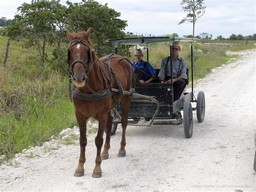
Mennonite father and son in buggy |
On the way, when nearly there, we got thoroughly lost. The usual Belizean habit is to not have signs along roads. This wasn't too bad going through small towns where we knew that it had to be straight ahead. But at the end we came to several points where our dirt road forked. When we finally spotted someone from whom we could ask directions it was a Mennonite man in a buggy with his son. Set off in the right direction by him we were lost again in less than a mile. Our next informant was driving a Pepsi Cola delivery truck. Fortunately he said "follow me" and waited at the (dirt and signless) junction where we had to turn.
Soon we passed the sign to the Lamanai ruins and sailed by to what we thought would be lunch at the Outpost Lodge. We discovered it to be a very fancy eco-tourism lodge that we vow to stay at when we are REALLY old and trying to unload what's left of our nest egg. As we were asking about lunch Gerry talked to the pilot (British of course) who was waiting to take a customer via the nearby landing strip to Belize City. It turns out that the guest in question was a former R.A.F. officer who used to run R.A.F. Catterick (an air force base south of Darlington). Another lodge guest was on the veranda using the house supplied internet service. (We borrowed it a moment to check email; that's how we learned with certainty that our friends Moshe and Cris had already been parents for 24 hours.) This day, though, we decided the rates for lodge or lunch were too much for us and went off to picnic.
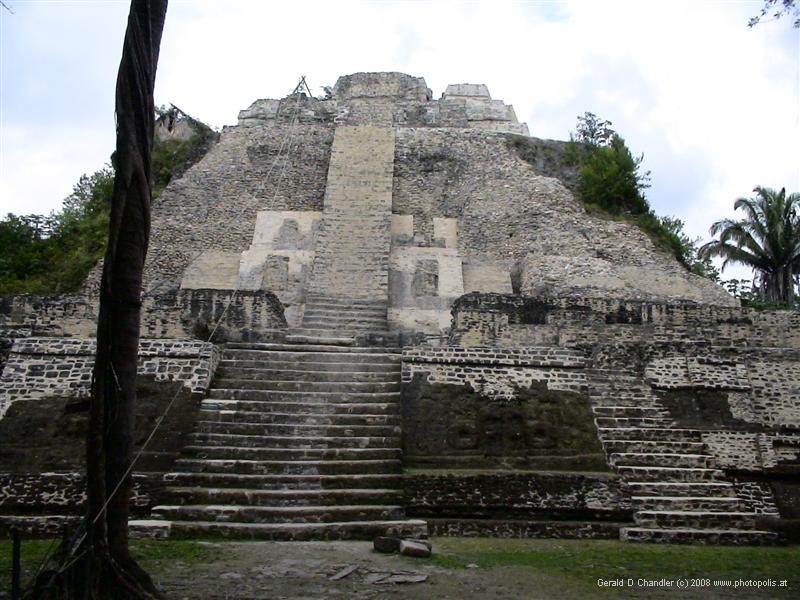
Lamanai pyramid temple |
The Lamanai ruins themselves are very impressive, or at least impressive to those easily impressed, such as groups from cruise ships who have never seen a Mayan ruin (or at least are ship-stir crazy) and Gerry, who is impressed by just about everything, but not to Jan, who as she put it, "was a tad bored." The site was probably first inhabited before 1500 BC, had its first stone buildings a thousand years later, and before it fell into ruins had at least three major Pyramid temples and an equal number of plazas with the standard Mayan buildings on four sides. Two of the pyramids are well excavated and largely restored, but major parts are still under jungle growth. One of the outstanding remains is a 10 foot high relief head. Gerry's guess is that it was somehow influenced by or a copy of a free-standing Olmec head. What the archeologists say we don't know.
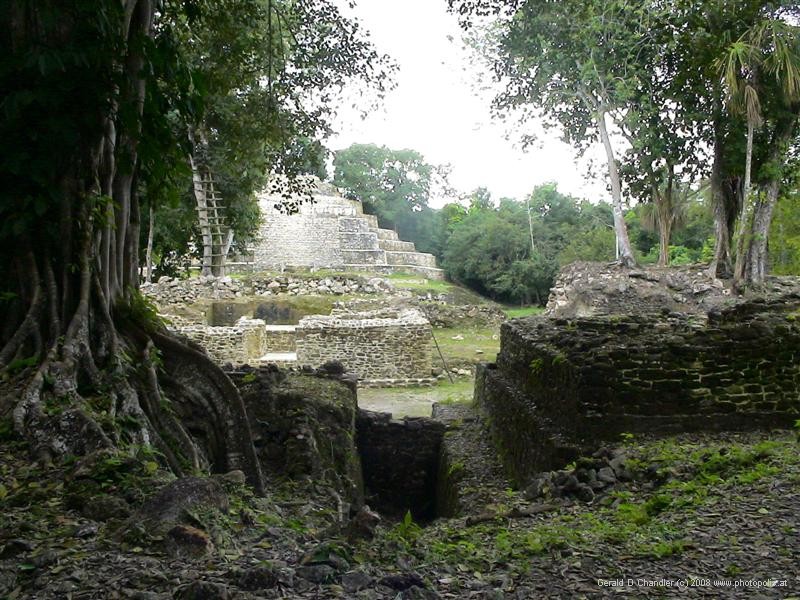
Lamanai |

Lamanai |
Leaving Lamanai in the late afternoon we took a more direct and less paved road back to Orange Walk. It was only 45 km but took us as long as the outbound 65 km. We didn't mind as it was very pretty farm country. Most of the area is inhabited by Mennonites, so we saw plenty of buggies, women in bonnets, men in coveralls, and identially dressed boys, matching right up to the hat. We did ask directions twice, but other than that had no conversation. We had learned from the morning's encounter with a Mennonite that in his community there were about 800 families and that the Mennonites had come to the area in the 1950s.